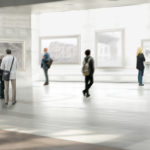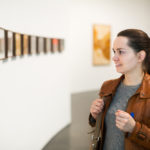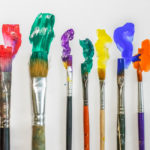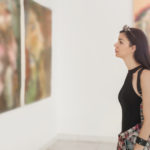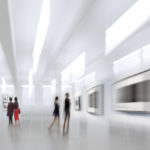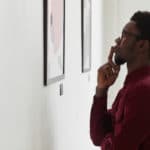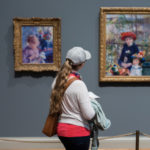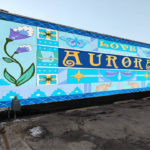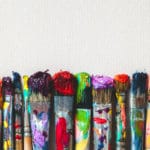Notable Exhibitions Happening Outside Chicago This Summer

Chicago exploded with activity last week when the city reached phase 5. It’s been a long year, and now that many restrictions are falling away, there are suddenly not enough hours in the day to do everything and see everyone. Traffic is telling that tale minute-by-minute in the city.
If you’re longing to and able to get away, there are several art exhibitions taking place outside of the City (in Illinois as well as Michigan, Indiana and Wisconsin) that may inspire you to escape for a day or weekend trip this summer.
Have a look at the following highlights, and enjoy the return of your freedom this summer (and perhaps a respite from Chicago traffic).
– The CGN team
Michigan’s Krasl Art Center: Art Fair on the Bluff and BLOW-UP
The 2021 Krasl Art Fair on the Bluff is back and in person this summer, celebrating artists and the community Saturday, July 10, and Sunday, July 11. Experience the talent of 155 artists from across the United States while enjoying the view and breezes of Lake Michigan and the charm and hospitality of St. Joseph, Michigan. Tickets start at $5.
While you’re there, check out BLOW UP II: Inflatable Contemporary Art, an exhibition exploring the medium of inflatable art with imagery that is figurative, conceptual, and abstract. These large-scale inflatable sculptures, conceived by nine artists and art collectives from around the world, connote fun and whimsy, are familiar yet strange, and challenge the definition of art. Here, in an unusual feat, artists use air as an active tool in their work to subvert our perspective and surprise us. Including work by Chromaforms, Sharon Engelstein, FriendsWithYou, Josh Harker, Susan Lee-Chun, Matt Ritchie, Lizabeth Rossof, Jen Stark, and Max Streicher – many of whom have never worked in the inflatable medium previously.
Private Eye: The Imagist Impulse in Chicago Art, at Newfields in Indianapolis
An expansive exhibition in Indianapolis features a collection profiled in the summer 2017 issue of CGN. In the mid-1960s, a cadre of adventurous young artists began exhibiting at the Hyde Park Art Center in Chicago. With myriad influences from Surrealism and non-Western art to comic books and popular culture, their audacious, highly idiosyncratic, and personal approach set them apart from contemporaries working on either the East or West Coast. By the mid-1970s, this loose-knit assembly was commonly referred to as the Imagists. Now, more than 50 years after their first appearance, the Chicago Imagists are regarded as among the most important postwar American artists.
Private Eye: The Imagist Impulse in Chicago Art is focused on works by artists who comprise the original Imagist exhibition groups along with independent artists who shared their iconoclastic sensibility. Also featured will be works by Chicago-based artists from the preceding generation, known as the Monster Roster, and a complementary selection of younger, Imagist-influenced artists.
The exhibition, on view through December 5, is drawn entirely from the collection of Drs. Michael Robertson and Christopher Slapak, one of the most comprehensive private collections of Chicago Imagist art, which has been promised to the IMA with some pieces already donated to the Museum.
Rockford Art Museum: Technicolor Constellations: Tales from the Permanent Collection
Now through September 26 you can over 50 selections from the Rockford Art Museum’s Modern and Contemporary Collection that tell the fascinating stories of how RAM built a public art collection. Technicolor Constellations invites visitors to connect with the captivating stories behind each artist and their work and find the links that brought the work to the museum. From private donors, foundations, artists, and acquisitions, this exhibition explores the importance of artwork donations, collectors and what it takes to get into a museum’s permanent collection.
Technicolor Constellations brings together work by 38 artists and includes painting, prints, sculpture, and video. Featured artists include Herman Aguirre, Alice Aycock, Jeff Koons, Kerry James Marshall, Tony Oursler, Diane Simpson, and Ken Warneke.
Kevin Beasley at the Snite Museum at Notre Dame (South Bend, IN)
The Snite Museum just welcomed visitors back in person on June 1. An installation to visit at the museum in person is Kevin Beasley’s Chair of the Ministers of Defense. This immersive installation explores ideas of power and race in America through theatrics reminiscent of the Roman Baroque. Here, renowned conceptual artist Beasley calls into focus Black liberation movements and ongoing imbalances of power experienced by Black Americans and marginalized men and women of color. The work maintains a formality often employed in religious imagery and in art intended to convey the divine right of leaders.
An empty, rattan “peacock” chair is at center; above is a house window clad in protective iron bars, evoking a stained-glass window. Flanking are archetypical Maasai and Zulu warrior shields, icons of African might. Surrounding are vaguely figurative, resin-infused sculptures made from t-shirts, housedresses, and du- rags—all items associated with contemporary urban culture.
On view through December 23. Other exhibitions as well as the museum’s sculpture garden are also accessible in person.
A Question of Emphasis: Louise Fishman Drawing at University of Illinois
A Question of Emphasis: Louise Fishman Drawing is the first career spanning exhibition and publication of Fishman’s works on paper from 1964 to the present. Running Aug 26, 2021 – Feb 26, 2022 at the Krannert Art Museum at the University of Illinois in Champaign, the project includes more than 100 works from the artist’s archive that have rarely been exhibited alongside significant institutional and private loans. Citing John Cage’s response in 1965 to the question, “what is drawing?” A Question of Emphasis encompasses collage, oil and wax, thread, acrylic text, ink, charcoal, printmaking, oil stick, watercolor, and tempera in Japanese-bound Leporello (accordion) books. This full range of mediums foregrounds Fishman’s robust and dedicated practice of works on paper, which have never been studies for her large canvases. Instead, Fishman has used drawing to think through physicality, materials, and intimacy on a different register: generally small- and medium- scale, often sculptural and tactile, and aligned to her particular historical contexts and her communities.

